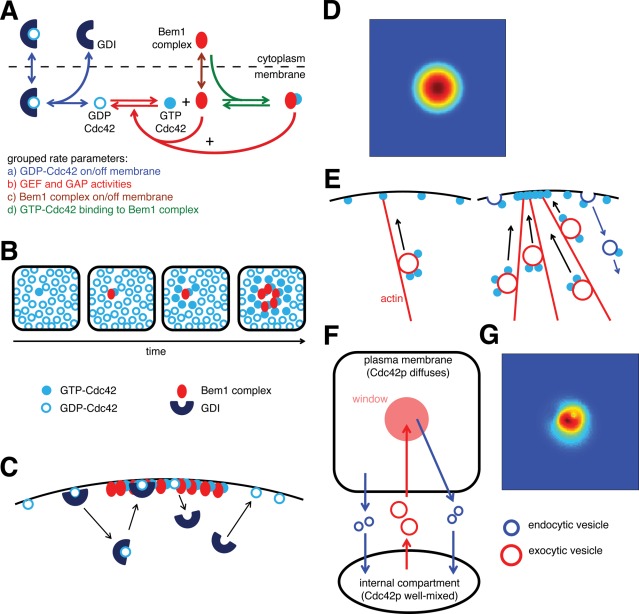FIGURE 1:
Cdc42p polarization via reaction-diffusion and vesicle-trafficking mechanisms. (A) Schematic of the reaction-diffusion model. +,positive feedback. (B) Positive feedback “grows” a cluster of GTP-Cdc42p. Stochastically arising GTP-Cdc42p recruits Bem1p complexes from the cytoplasm, promoting GTP loading of neighboring Cdc42p, and hence more Bem1p recruitment. (C) Cytoplasmic delivery of GDP-Cdc42 to the polarity patch via GDI. GDI extracts GDP-Cdc42p from the membrane to the cytoplasm, and returns it to the membrane. If GDI delivers GDP-Cdc42 to the polarity patch, Cdc42 becomes GTP-bound and thus protected from GDI removal, so the GDI mediates a net transfer of Cdc42p from outside to inside the cluster. (D) The square represents the plasma membrane, and the color indicates Cdc42p concentration (red, high; blue, low). A simulation of the scheme shown in (A) combined with diffusion was initiated with a small GTP-Cdc42p stimulus in the center of the membrane and developed the steady-state Cdc42p distribution shown. (E) Actin-mediated feedback loop. Cdc42p at the plasma membrane can nucleate an actin cable, which delivers vesicles carrying more Cdc42p to that site. The delivered Cdc42p can nucleate more actin cables, which deliver more vesicles containing Cdc42p, growing a cluster of Cdc42p. Endocytosis (blue arrows) returns Cdc42p to internal pools before it diffuses too far from the cluster. (F) Schematic of the vesicle-trafficking model. (G) A simulation of the scheme shown in (F) with traffic of vesicles carrying concentrated Cdc42p to/from a small central window yielded a fluctuating but polarized Cdc42p distribution (snapshot shown).

